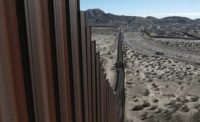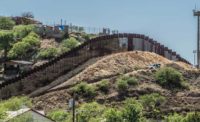President Donald Trump’s campaign pledge to build a massive wall along the border with Mexico has been dogged by concerns over funding as well as engineering challenges posed by some of the continent’s roughest, most remote terrain.
Funding for the border wall became a sticking point in negotiations over a fiscal 2017 spending bill to keep the federal government operating past April 28, the deadline for a stopgap measure. But at ENR press time, the White House had backed away from including the wall funding in the spending measure, according to multiple reports.
"I'm absolutely convinced the initial folks who were putting the RFP out weren't fans of the idea."-Michael Hari, Crisis Resolution Security Services.
Despite on-again, off-again funding strategies, there remains an ample supply of outside-the-box proposals from small architectural and engineering shops and security firms hoping to profit from what could be one of the largest public works projects in decades.
The Dept. of Homeland Security’s call for design concepts for the controversial 2,000-plus-mile border wall, a huge federal public works project, has elicited a torrent of futuristic schemes for which there are few prototypes.
However, the larger companies that usually compete for big government contracts have been less conspicuous, in some cases taking themselves out of the bidding. Among the missing are concrete firms near the border that would be logical competitors for work on the wall.
Meanwhile, some of the smaller design competitors say they have been frustrated by a confusing contracting process that has proceeded by fits and starts.
“I am absolutely convinced the initial folks who were putting this RFP out weren’t fans of the idea,” says one bidder, Michael Hari, chief executive of Crisis Resolution Security Services, Clarence, Ill. “I don’t think they took it seriously.”
Futuristic, Multi-Use Border Wall Proposals
Bidders and government bidding documents have suggested a swift review process possibly ending in early June with a selection of prototypes to be tested out along the border in the San Diego area. However, a spokesman for Customs and Border Protection, which is directly overseeing the process, would only say a decision will be made in the summer.
Crews will test the prototypes, which will need to withstand assault from 90 minutes to four and a half hours by “sledgehammer, car jack, pick axe and oxy/acetylene torch," among other tools, according to bid documents.
Next, the agency will pare the list to four to 10 companies, each of which will build prototypes along the border, according to an Associated Press report. s.
If there is one theme to the proposals that have been unveiled so far, it is a big effort to make the wall something more than just a concrete barrier.
Hari, who runs a security management firm, is betting bigger is better. The one-time patrolman and corrections officer wants to build a 56-ft-high wall, well above DHS’ specified 30-ft minimum. Hari’s proposal has two parts, a 26-ft wall atop a 30-ft earth berm, similar to those used on interstate highway ramps, he noted. The 26-ft wall would not be solid concrete but, rather, two retaining walls with packed earth in the middle.
Hari is taking his inspiration in part from Hadrian’s Wall in the U.K., built nearly 1,900 years ago by the Roman emperor of the same name, and the Great Wall of China. “There’s no way to make something permanent that works better than [by] making it massive,” said Hari.
But Hari’s wall offers not only security but also a road on top, so that pedestrians and bikers can enjoy the desert views.
By contrast, Thomas Gleason, managing partner of a small, Las Vegas-based solar outfit, is sticking with the suggested 30-ft minimum.
Gleason Partners LLC, whose biggest project to date has been a solar project at a tank plant in Warren, Mich., proposes creating a solar-paneled curtain wall; on top, another array of solar panels would follow the sun.
Gleason says the solar panels would power the lights and sensors along the wall as well as, within 20 years, pay for the entire cost, which he pegs at $6 million to $7 million a mile.
Gaps in the solar-panel-clad wall would be kept too small to provide footholds for climbers. Lights and cameras would periscope up and down, eliminating anything for a grappling hook to snag.
One idea is a partially buried, monolithic concrete-and-steel box culvert carrying salt water from the Pacific Ocean to the Gulf of Mexico.
Frank K. Johnson, a civil engineer from Andover, Mass., who says he has worked on big infrastructure projects around the world, contends his proposal would generate electricity and serve as a giant “economic development” project for the U.S. and Mexico. The centerpiece of Johnson’s proposal is a saltwater river that would flow more than 2,000 miles along the border through a giant, partially buried, monolithic concrete-and-steel box culvert. In Johnson’s “economic development” alternative, the river’s water would be desalinized for use in desert regions and employed as a power source for generating electricity.
But Phoenix-based DarkPulse Technologies is focusing strictly on security, hoping to bring a more high-tech solution to the work. The company develops remote monitoring systems for oil-and-gas operations. Dennis O’Leary, the company’s CEOTried to crumble the concrete to be used in DarkPulse’s wall with a tank round, sees an opportunity to put the firm’s monitoring systems, now used to detect leaks, to a new application.
Border Wall Idea: Embedded Motion-Sensors
Embedded in the wall itself as well as in the ground up to one kilometer away from the wall, fiber sensors would detect very light movements, especially foot traffic, along the surface, O’Leary says.
If someone were able to clamber over the wall, border guards would be alerted to the breach. Monitoring screens would display the intruders’ footprints, allowing border security to track the border crossers’ speed and direction.
Further, the wall would consist of ballistic-strength concrete, designed by a California company that is also DarkPulse’s partner, he notes. In the U.K., the British army tried to crumble the concrete to be used in DarkPulse’s wall with a tank round and a rocket-propelled grenade and even tried to set it on fire—all to no avail. “It withstood everything they threw at it,” O’Leary beams.
Not everyone is pushing the envelope. Michael Noe, head of Dominion Earthworx LLC, Anchorage, proposes a simple border wall, rather than a dual-purpose structure. His value-add comes in the material, fiber-reinforced plastic with a mix of concrete, which will provide both greater durability and lower cost. “A lot of this stuff is wildly afield from what the RFP requested,” Noe said.
Larger Federal Infrastructure Contractors Hanging Back
More than 750 different firms have expressed interest in the border-wall project, but many are smaller operations or even solo consulting firms. While many of the smaller companies have submitted very creative proposals, most major engineering and architectural players have been hanging back.
Some big companies signed for information, but few offered detailed proposals. The “interested vendors” list includes Mass Electric Construction, Zachry Federal Construction, CB&I Federal Services, Traylor Bros., Tutor Perini, Caddell Construction and Fluor Federal Solutions.
Some smaller bidders interviewed by ENR say they are working with larger players that don’t want to be identified.
Noe says he is working with a top engineer that can’t be named due to a confidentiality agreement. Johnson claims support from a pair of top industry executives who seek anonymity.
State and municipal officials in California and New York are pushing proposals that, effectively, would blacklist firms that bid work on the border wall.
Fearful of the backlash, larger firms have been careful in even exploring the project, says Gleason, the solar-power consultant. “What it has done is eliminate a lot of the big boys,” he says.
The process has frustrated companies that already have filed proposals.
Hari foresees problems with DHS’ plan to break the project into separate, $300-million contracts for different bidders to build the different wall sections. “To be blunt, I think they are going to cancel this thing and redo it,” he said.








Post a comment to this article
Report Abusive Comment